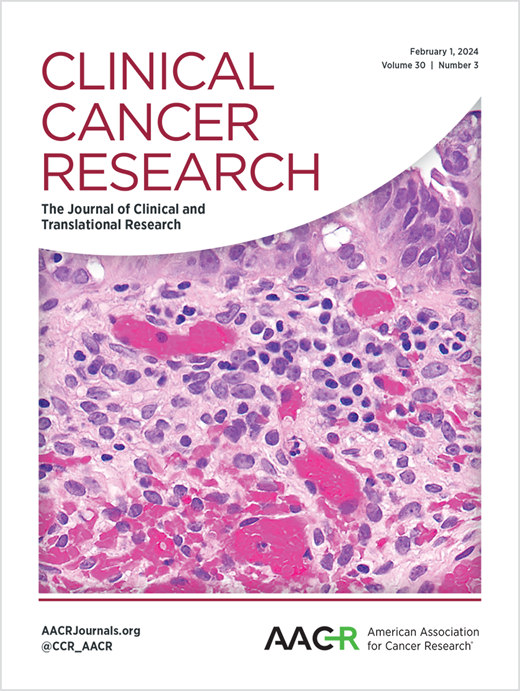Exploiting WEE1 kinase activity as FUS::DDIT3-dependent therapeutic vulnerability in myxoid liposarcoma
IF 10
1区 医学
Q1 ONCOLOGY
引用次数: 0
Abstract
Purpose: The pathognomonic FUS::DDIT3 fusion protein drives myxoid liposarcoma (MLS) tumorigenesis via aberrant transcriptional activation of oncogenic signaling. Since FUS::DDIT3 has so far not been pharmacologically tractable to selectively target MLS cells, this study investigated the functional role of the cell cycle regulator WEE1 as novel FUS::DDIT3‑dependent therapeutic vulnerability in MLS. Experimental Design: Immunohistochemical evaluation of the cell cycle regulator WEE1 was performed in a large cohort of MLS specimens. FUS::DDIT3 dependency and biological function of the G1/S cell cycle checkpoint were analyzed in a mesenchymal stem cell model and liposarcoma cell lines in vitro. WEE1 activity was modulated by RNAi‑mediated knockdown and the small molecule inhibitor MK-1775 (Adavosertib). An established MLS cell line-based chicken chorioallantoic membrane model was employed for in vivo confirmation. Results: We demonstrate that enhanced WEE1 pathway activity represents a hallmark of FUS::DDIT3‑expressing cell lines as well as MLS tissue specimens and that WEE1 is required for MLS cellular survival in vitro and in vivo. Pharmacologic inhibition of WEE1 activity results in DNA damage accumulation and cell cycle progression forcing cells to undergo apoptotic cell death. In addition, our results uncover FUS::DDIT3-dependent WEE1 expression as an oncogenic survival mechanism to tolerate high proliferation and resulting replication stress in MLS. Fusion protein-driven G1/S cell cycle checkpoint deregulation via overactive Cyclin E/CDK2 complexes thereby contributes to enhanced WEE1 inhibitor sensitivity in MLS. Conclusions: Our preclinical study identifies WEE1-mediated replication stress tolerance as molecular vulnerability in FUS::DDIT3-driven MLS tumorigenesis that could represent a novel target for therapeutic intervention.利用 WEE1 激酶活性作为肌样脂肪肉瘤中 FUS::DDIT3 依赖性治疗的弱点
目的:致病性的FUS::DDIT3融合蛋白通过异常转录激活致癌信号转导来驱动肌样脂肪肉瘤(MLS)的肿瘤发生。由于FUS::DDIT3迄今为止还不能在药理学上选择性地靶向MLS细胞,本研究探讨了细胞周期调节因子WEE1作为FUS::DDIT3依赖性新型治疗漏洞在MLS中的功能作用。实验设计:在一大批 MLS 标本中对细胞周期调节因子 WEE1 进行免疫组化评估。在间充质干细胞模型和体外脂肪肉瘤细胞系中分析了FUS::DDIT3依赖性和G1/S细胞周期检查点的生物学功能。通过RNAi介导的基因敲除和小分子抑制剂MK-1775(Adavosertib)调节了WEE1的活性。为了进行体内确认,采用了已建立的基于 MLS 细胞系的鸡绒毛膜模型。结果:我们证明,WEE1通路活性的增强代表了FUS::DDIT3表达细胞系以及MLS组织标本的特征,而且WEE1是MLS细胞在体外和体内存活所必需的。药物抑制 WEE1 的活性会导致 DNA 损伤积累和细胞周期进展,迫使细胞凋亡。此外,我们的研究结果还发现,FUS::DDIT3 依赖性 WEE1 表达是一种致癌生存机制,可抑制 MLS 的高增殖和由此产生的复制压力。融合蛋白通过过度活跃的细胞周期蛋白 E/CDK2 复合物驱动 G1/S 细胞周期检查点失调,从而增强了 MLS 中 WEE1 抑制剂的敏感性。结论:我们的临床前研究发现,WEE1介导的复制压力耐受性是FUS::DDIT3驱动的MLS肿瘤发生过程中的分子漏洞,可能成为治疗干预的新靶点。
本文章由计算机程序翻译,如有差异,请以英文原文为准。
求助全文
约1分钟内获得全文
求助全文
来源期刊

Clinical Cancer Research
医学-肿瘤学
CiteScore
20.10
自引率
1.70%
发文量
1207
审稿时长
2.1 months
期刊介绍:
Clinical Cancer Research is a journal focusing on groundbreaking research in cancer, specifically in the areas where the laboratory and the clinic intersect. Our primary interest lies in clinical trials that investigate novel treatments, accompanied by research on pharmacology, molecular alterations, and biomarkers that can predict response or resistance to these treatments. Furthermore, we prioritize laboratory and animal studies that explore new drugs and targeted agents with the potential to advance to clinical trials. We also encourage research on targetable mechanisms of cancer development, progression, and metastasis.
 求助内容:
求助内容: 应助结果提醒方式:
应助结果提醒方式:


